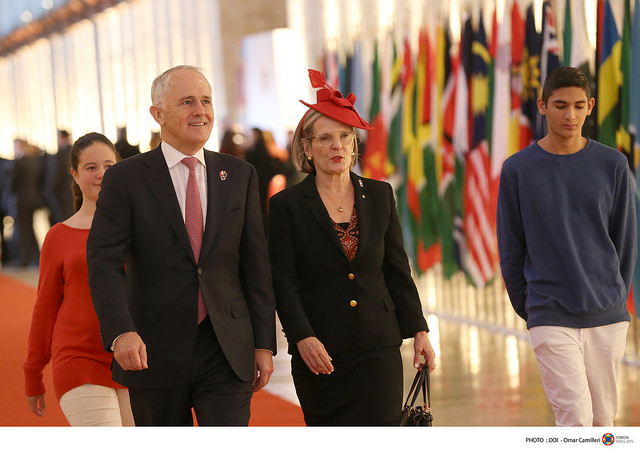by Dr Eva Namusoke
The 26th January is the anniversary of the 1788 arrival in Australia of the First Fleet – made up of 11 ships that had travelled from Great Britain – and subsequent founding of the country on what is now known as Australia Day. While the day has traditionally been marked by celebrations and demonstrations of national pride, there is a growing importance being placed on reckoning with Australia’s uncomfortable past, particularly regarding the treatment of Indigenous people who had already inhabited the land for tens of thousands of years. For this reason, 26th January is known by many Indigenous people as Invasion Day or the Day of Mourning and was marked across the country by protests and rallies.

Commonwealth Heads of Delegations arriving for the CHOGM Opening Ceremony
H.E. Malcolm Turnbull, Prime Minister of the Commonwealth of Australia CHOGM Malta 2015 photo by Omar Camilleri
As Australia continues to engage with a painful national history, this year has also seen renewed calls for the country to reconsider its relationship with the British monarchy. Specifically, there has been a greater interest in what some consider a long overdue transition to a republic. In 1999, Malcolm Turnbull, now prime minister, led a republican movement that resulted in a failed referendum. Soon after his 2015 election, Prime Minister Turnbull stated that a new referendum would be held after the Queen’s reign ended; however there are now calls for a referendum during her lifetime. Ahead of this year’s Australia Day, all but one of the state and territory leaders signed a declaration supporting the transition to a republic with an Australian head of state. The one abstention agreed with the republican movement in principle but felt the time was not yet right. On Australia Day, Prime Minister Turnbull restated his support for an Australian republic, but again added – to the disappointment of avowed republicans – that ‘the timing of that referendum has to be right’ and it should take place after the Queen’s reign ends.
Of the 53 states that make up the Commonwealth, 33 are republics with a president as head of state. If Australia were to become a republic, recent historic precedent shows there would be no real change in its relationship to the Commonwealth. The process of reapplication was scrapped following the 2007 Kampala Communique so it would effectively be business as usual for a republic of Australia.
Despite the range of governments represented – constitutional monarchies and republics alike – it is clear from the Commonwealth Oral History Project that those interviewed value the role played by the Queen in her Headship of the Commonwealth. Her active interest in Commonwealth matters and decades-long leadership amongst a slew of changing heads of state have been noted by many COHP interviewees as key to holding the Commonwealth together. Quite simply, the Queen may not be the head of state of most Commonwealth nations but still commands a great deal of respect and goodwill from those in power.
One of the Australians interviewed was former Prime Minister John Howard, who had been in office during the 1999 referendum. Howard stressed the relationship shared between nations that still have the Queen as head of state, although he noted that whether or not Australia became a republic, ‘most Australians would not want to leave the Commonwealth, they’d continue to support it quite strongly.’ Hugh Craft, an Australian diplomat who worked in the Department of the Prime Minister and Cabinet during the 1999 referendum also commented on the difference between her role as head of state and her Headship of the Commonwealth: ‘The Queen’s role in Australia is obviously contentious and people hold views passionately one way or the other. But in terms of the Commonwealth, I don’t think anyone disputes that she’s been a binding force and an exemplary Head.’
